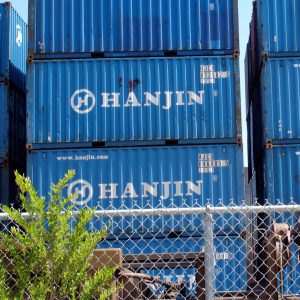Hanjin Collapse Inundates Southern California with Containers; Fails to Revive Shipping Rates
Hanjin Shipping, the world’s seventh largest container carrier and the largest in South Korea, filed for bankruptcy and receivership in South Korea in late August 2016, sending a ripple of effects throughout the global supply chain. The collapse is the result of what Hanjin Group chairman Cho Yang-ho described as a “game of chicken played among large shippers.”
That game was sparked by freight rates declining to historic lows due to overcapacity and weak demand in the global shipping industry. Carriers have taken a variety of steps to help themselves weather the storm, but scaling back capacity has not been among them.

Hanjin, already about $5.5 billion in debt at the end of June, decided to pursue receivership after its creditors cut off further financial support. The move immediately stranded Hanjin’s shipping fleet in transit on the world’s oceans. The ships were unable to dock at their destinations due to concerns that creditors would seize Hanjin vessels and other assets. Though a New Jersey court eventually granted Hanjin temporary protection from such seizures in the United States, many terminals refused to accept Hanjin ships for unloading for fear that the company would be unable to pay for the terminals’ services. Hanjin eventually received an influx of cash to help unload the ships, but many were stranded for as long as a few weeks. The unloading process is ongoing, with 64 of Hanjin’s 97 ships unloaded as of October 9.
The collapse has also passed negative effects throughout the supply chain. With ships unavailable to pick them up, Hanjin containers have begun piling up in parking lots, warehouses, and port terminals, particularly in the vicinity of the Ports of Los Angeles and Long Beach, two of the nation’s busiest. Even more concerning is that many of these containers are sitting on top of chassis, trailers used to carry containers on roads. With no one to unload the containers, many chassis are sitting idle, leading many in the industry to fear a possible chassis shortage. As of October 11, Hanjin announced that the Pier T terminal in Long Beach and Terminal 46 in Seattle would begin accepting Hanjin-owned empty containers. The Port of Oakland similarly set up a three-acre zone to accept and store Hanjin containers. However, the new initiatives do little for those stuck with leased containers, which Hanjin will not be accepting at its terminals. An estimated 12,000 to 15,000 containers are still taking up space throughout the United States.
Some had theorized that the collapse of Hanjin might offer some relief from overcapacity in the industry. Indeed, shipping rates along Asia-North America routes experienced a brief spike following news of Hanjin’s collapse. Hyundai Merchant Marine (HMM), Hanjin’s South Korean rival, and Maersk Line initially stepped in to absorb excess demand on the routes and to capitalize on the rate spike, but prices quickly settled back down, reflecting continuing weak demand. HMM reportedly scaled back its additional services along Asia-North America routes from 13 additional ships to just one in response to prices leveling off.
Questions now remain about exactly how the market will handle Hanjin’s absence – and about whether that absence will be long term, with some expecting Hanjin to be liquidated by the end of the year.
Sources and Further Reading:
